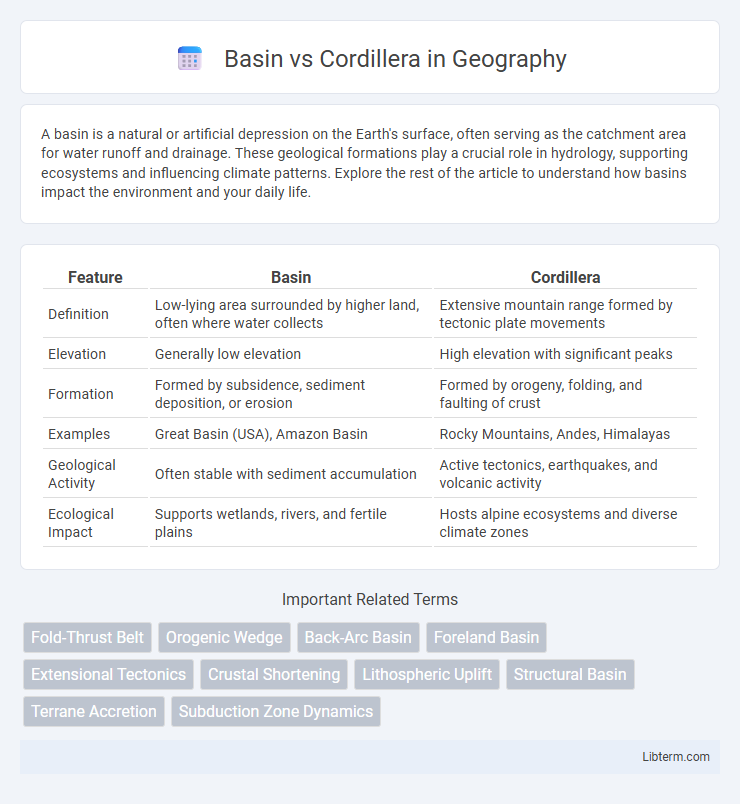A basin is a natural or artificial depression on the Earth's surface, often serving as the catchment area for water runoff and drainage. These geological formations play a crucial role in hydrology, supporting ecosystems and influencing climate patterns. Explore the rest of the article to understand how basins impact the environment and your daily life.
Table of Comparison
| Feature | Basin | Cordillera |
|---|---|---|
| Definition | Low-lying area surrounded by higher land, often where water collects | Extensive mountain range formed by tectonic plate movements |
| Elevation | Generally low elevation | High elevation with significant peaks |
| Formation | Formed by subsidence, sediment deposition, or erosion | Formed by orogeny, folding, and faulting of crust |
| Examples | Great Basin (USA), Amazon Basin | Rocky Mountains, Andes, Himalayas |
| Geological Activity | Often stable with sediment accumulation | Active tectonics, earthquakes, and volcanic activity |
| Ecological Impact | Supports wetlands, rivers, and fertile plains | Hosts alpine ecosystems and diverse climate zones |
Introduction to Basins and Cordilleras
Basins are low-lying geological depressions often filled with sediment, playing a crucial role in hydrocarbon accumulation and groundwater storage. Cordilleras are extensive mountain ranges formed by tectonic plate interactions, characterized by complex structures and significant elevation changes. Understanding the formation, characteristics, and spatial distribution of basins and cordilleras is essential for geological mapping and resource exploration.
Geological Definitions: Basin vs Cordillera
A basin is a low-lying geological depression typically filled with sedimentary deposits, often formed by tectonic subsidence or erosion. A cordillera refers to an extensive sequence of mountain ranges formed mainly by tectonic plate interactions, including folding, faulting, and volcanic activity. While basins represent sedimentary environments shaped by crustal downwarping, cordilleras embody orogenic belts characterized by uplift and complex structural deformation.
Formation Processes of Basins
Basins form primarily through tectonic subsidence, sediment compaction, and erosion processes, often created in areas of crustal extension or downwarping. These geological depressions accumulate sediments over time, driven by mechanisms such as rift basin formation, thermal subsidence, or flexural depression due to orogenic loading. In contrast, cordilleras arise from crustal compression, mountain-building processes like folding and faulting related to convergent plate boundaries.
Formation Processes of Cordilleras
Cordilleras form primarily through the process of plate tectonics, where convergent boundaries cause the collision and subduction of lithospheric plates, resulting in intense folding, faulting, and uplift of the Earth's crust. These mountain ranges often develop due to orogenic events, where compressional forces create complex structures such as thrust faults and metamorphic cores. Unlike basins, which are formed by sediment deposition or crustal extension, cordilleras arise from active orogeny and lithospheric deformation.
Topographical Differences: Basin vs Cordillera
Basins are low-lying, flat or gently sloping areas often surrounded by higher land, characterized by sediment accumulation and relatively minimal elevation changes. Cordilleras consist of extensive mountain ranges with rugged terrain, steep slopes, and significant elevation variations formed by tectonic plate interactions. The key topographical difference lies in basins' broad, depressed surfaces contrasting with the cordilleras' towering peaks and narrow ridges.
Ecological Significance of Basins and Cordilleras
Basins serve as crucial ecological zones by supporting diverse wetland habitats and acting as natural water reservoirs that sustain flora and fauna, while Cordilleras create varied microclimates and altitudinal gradients fostering unique biodiversity hotspots. Basins often facilitate nutrient-rich sediment deposition that enhances soil fertility, promoting productive ecosystems. In contrast, Cordilleras influence regional climate patterns and water cycles, supporting endemic species adapted to rugged mountainous environments.
Economic Importance and Resources
Basins often serve as fertile agricultural zones due to rich alluvial soils and abundant water resources, supporting crop production and livestock farming, while also containing significant reserves of oil, natural gas, and coal. Cordilleras, characterized by mountainous terrains, are rich in mineral deposits such as gold, copper, silver, and other valuable metals, making mining a major economic activity in these regions. The diverse ecosystems of cordilleras also contribute to hydroelectric power generation and ecotourism, enhancing their economic significance beyond resource extraction.
Human Settlements and Activities
Human settlements in basins often capitalize on fertile soil and access to water sources, supporting agriculture and dense populations. In contrast, cordilleras, characterized by rugged terrain and higher elevations, tend to have sparse settlements focused on mining, tourism, and pastoralism. Infrastructure development in cordilleras faces challenges due to steep slopes and seismic activity, impacting transportation and urban expansion.
Major Basins and Cordilleras Worldwide
Major basins such as the Amazon Basin in South America, the Congo Basin in Africa, and the Ganges Basin in Asia serve as vast sedimentary depocenters crucial for hydrocarbon reservoirs and freshwater resources. Prominent cordilleras, including the North American Cordillera, the Andes in South America, and the Himalayas in Asia, represent extensive mountain systems formed by tectonic plate convergence, hosting significant mineral deposits and influencing regional climate. These geological features are essential for understanding Earth's tectonic processes, biodiversity distribution, and resource management on a global scale.
Comparative Analysis: Basin vs Cordillera
Basins are low-lying regions typically formed by sediment accumulation and subsidence, characterized by flat terrain and often serving as sites for water drainage and resource deposits. Cordilleras, in contrast, are extensive mountain ranges formed by tectonic plate interactions, featuring rugged terrain, high elevations, and significant geological diversity. The comparative analysis reveals basins emphasize sedimentary processes and resource accumulation, while cordilleras highlight orogenic activity and complex structural geology.
Basin Infographic

 libterm.com
libterm.com